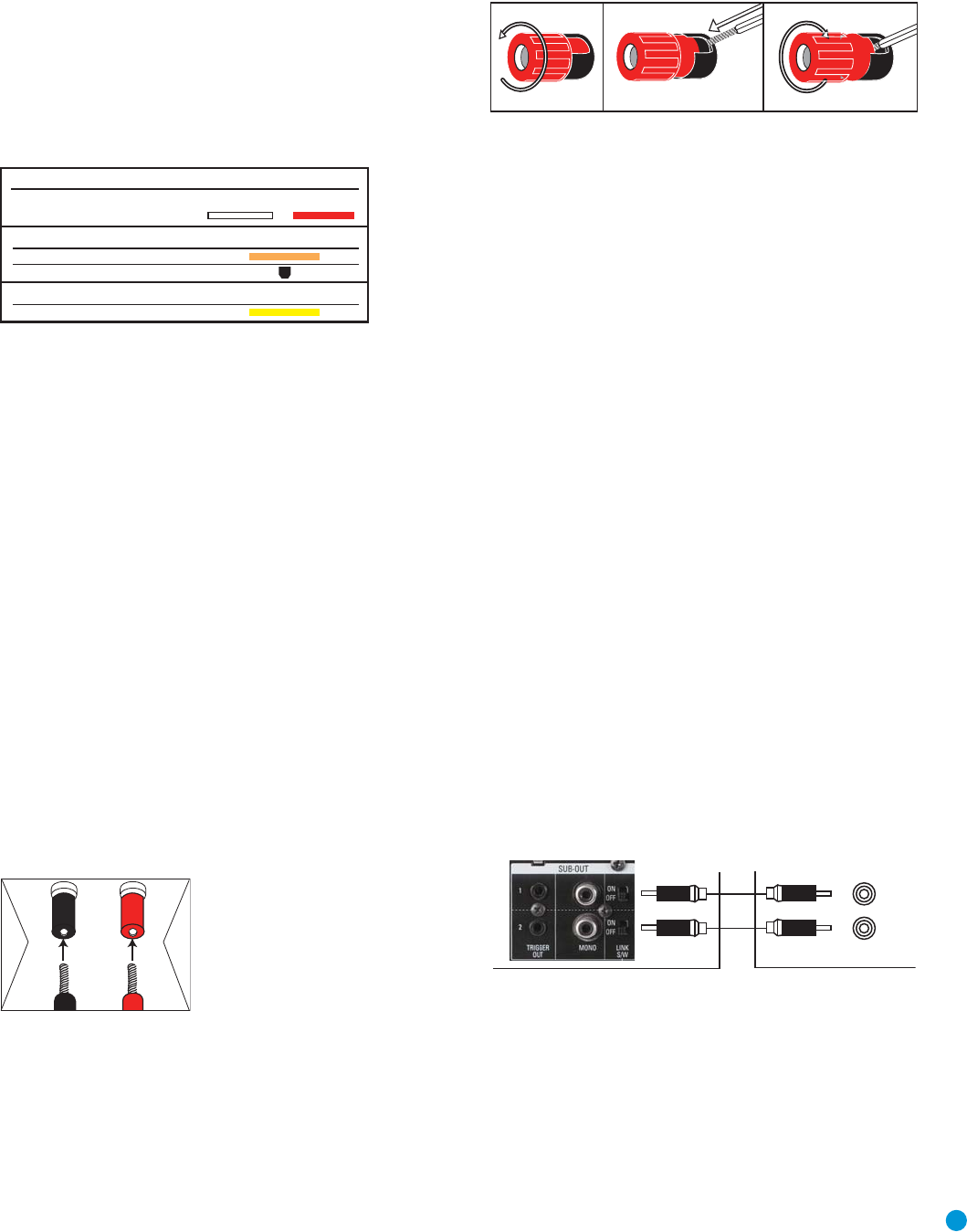
15
CONNECTIONS
There are different types of audio and video connections used to
connect the receiver to the speakers and video display, and to connect
the source devices to the receiver. To make it easier to keep them all
straight, the Consumer Electronics Association has established a CEA
®
color-coding standard. Table 1 may be helpful to you as a reference
while you set up your system.
Table 1 – Connection Color Guide
Types of Connections
This section will briefly review different types of cables and connections
that you may use to set up your system.
Speaker Connections
Speaker cables carry an amplified signal from the receiver’s speaker
terminals to each loudspeaker. Speaker cables contain two wire
conductors, or leads, inside plastic insulation. The two conductors are
usually differentiated by using different colors, or stripes, or by adding a
ridge to the insulation. Sometimes the wires are different colors, one
being copper red and the other silver.
The differentiation is important because each speaker must be connected
to the receiver’s Speaker-Output terminals using two wires, one positive
(+) and one negative (–). This is called speaker polarity. It’s important
to maintain the proper polarity for all speakers in the system. If some
speakers have their negative terminals connected to the receiver’s
positive terminals, performance can suffer, especially for the low
frequencies.
Always connect the positive terminal on the loudspeaker, which is usually
colored red, to the positive terminal on the receiver, also colored red.
Similarly, always connect the black negative terminal on the speaker to
the black negative terminal on the receiver.
The HK 3490 uses binding-post speaker
terminals that can accept banana plugs
or bare-wire cables.
Banana plugs are simply plugged into the
hole in the middle of the terminal cap.
See Figure 1.
Figure 1– Binding-Post Speaker Terminals With Banana Plugs
Bare-wire cables are installed as follows (see Figure 2):
1. Unscrew the terminal cap until the pass-through hole in the collar
is revealed.
2. Insert the bare end of the wire into the hole.
3. Screw the cap back into place until the wire is held snugly.
Figure 2 – Binding-Post Speaker Terminals With Bare Wires
The HK 3490 features two sets of speaker connections, with each set
allowing connection of a left and right loudspeaker. This allows you to
place a second set of speakers in another room, or even outdoors,
when weather-resistant loudspeakers are used. You may play both sets
of speakers simultaneously, one set at a time or neither set when using
the headphones or making recordings. Use the Speaker 1/2 Buttons to
activate or deactivate each pair of speakers. It is not possible to select
different sources for each speaker pair.
Subwoofer
The subwoofer is a specialized type of loudspeaker used to play only
the low frequencies (bass), which require much more power than the
other speaker channels. To obtain the best results, most speaker
manufacturers offer powered subwoofers, in which the speaker contains
its own amplifier on board. Usually, a line-level (nonamplified) connection
is made from the receiver’s Subwoofer Output to a corresponding jack
on the subwoofer, as shown in Figure 3, but sometimes the subwoofer
is connected to the receiver using the left and right speaker outputs,
then the left and right speakers are connected to terminals on the
subwoofer. The same full-range signal is output through both jacks.
Thus, you have the option of connecting each jack to the line-level input
on a separate subwoofer. If you have only one subwoofer with a single
line-level input, connect it to the right Subwoofer Output on the HK 3490.
Connect the Subwoofer Trigger Output for each subwoofer to the
corresponding trigger input on its amplifier. This enables the subwoofer to
turn on or off together with the HK 3490. To further conserve energy,
when the trigger connection is made, turn the Subwoofer Link Switch on
to turn the subwoofer off when the corresponding pair of main speakers
are not being used, such as during muting, when headphones are being
used, or when the main speakers are turned off using the Speaker 1/2
switch.
Figure 3 – Subwoofer
Connecting Source Devices to the HK 3490
The HK 3490 is designed to process audio and video input signals,
playing back the audio and displaying the video on a television or
monitor connected to it. These signals originate in what are known as
“source devices,” including your DVD player, CD player, DVR (digital
video recorder) or other recorder, tape deck, game console, cable or
satellite television box, or MP3 player. Although the tuner is built into the
Subwoofer
L
R
12 3
+
Audio Connections
Left Right
Front (FL/FR)
Digital Audio Connections
Coaxial
Optical Input
Video Connections
Composite
HKP1696-3490.qxd 4/22/08 3:37 PM Page 15


















